Mastering Dog Training: The 5 Golden Rules
Learn the secrets to effective dog training and start building a stronger bond with your pet today.
Imagine your dog obeying every command with ease. It’s not magic—it’s the power of the five golden rules of dog training.
Many dog owners struggle with inconsistent training results and confusion about the best time to start training.
This post will guide you through the five golden rules of dog training, answering your pressing questions and giving you actionable tips for success.
- Consistency is the foundation of effective dog training.
- Patience and timing make training more impactful and enjoyable.
- Positive reinforcement builds trust and improves outcomes.
Start with Brain Training for Dogs and see the difference today!

What Are the 5 Golden Rules of Dog Training?
🌱 Takeaways
- Consistency is key: always reward the same behaviors.
- Timing matters: reward within 2 seconds of the desired action.
- Positive reinforcement builds trust and enhances learning.
📄 The five golden rules of dog training provide a clear framework for successful, stress-free learning. By focusing on consistency, timing, clear communication, patience, and positive reinforcement, you can transform your dog’s behavior and deepen your bond.
The five golden rules of dog training are designed to make learning straightforward and enjoyable for both you and your dog.
First, consistency ensures your dog knows exactly what to expect and what behaviors are rewarded.
Second, timing is critical—reward within 2 seconds to clearly connect the behavior with the reward.
Third, clear communication, using simple and repeatable cues, minimizes confusion.
Fourth, patience allows your dog to learn at their own pace, avoiding frustration for both parties.
Finally, positive reinforcement fosters trust and motivates your dog to repeat desired behaviors without fear or anxiety.

Rule 1: Consistency is Key
🌱 Takeaways
- Consistency helps your dog understand what behavior is expected.
- Always use the same cues and rewards for specific actions.
- Inconsistent training leads to confusion and slower learning.
📄 Consistency is the cornerstone of effective dog training. By using the same cues, actions, and rewards each time, your dog quickly learns what is expected and feels more secure in their environment.
Consistency forms the foundation of all successful dog training. Dogs thrive on routine and clear expectations. When teaching commands, use the same word, tone, and gesture every time to avoid confusion. For example, if you use 'sit' to ask your dog to sit, always say 'sit'—don’t switch to phrases like 'sit down' or 'take a seat.' Similarly, reward the same behaviors consistently to reinforce the lesson. Whether you use treats, praise, or playtime as rewards, make sure they follow the desired action immediately. By staying consistent, you create a structured environment that makes learning intuitive and enjoyable for your dog.

Rule 2: Timing Matters
🌱 Takeaways
- Rewards must be given within 2 seconds of the desired behavior.
- Delayed responses can confuse your dog and weaken learning.
- Using tools like a clicker can improve timing precision.
📄 Timing is crucial for effective dog training. Rewarding your dog immediately after a desired behavior helps them associate the action with the reward, strengthening their learning.
The timing of your rewards is just as important as the rewards themselves. For a dog to understand the connection between their behavior and the reward, it must be given within 2 seconds of the action. For instance, if your dog sits and you delay rewarding them, they might not realize the reward is tied to sitting. This gap can lead to confusion and slower learning. A clicker can help bridge this gap by marking the precise moment your dog performs the desired action, making it easier for them to learn and repeat good behaviors.

Rule 3: Patience Is Essential
🌱 Takeaways
- Every dog learns at their own pace, so avoid rushing the process.
- Stay calm and supportive to build a positive training experience.
- Frustration can hinder progress and harm the trust between you and your dog.
📄 Patience is the key to successful dog training. By allowing your dog to learn at their own pace, you create a stress-free environment that fosters trust and long-term results.
Patience is the bridge between frustration and success in dog training. Dogs, like people, have unique learning speeds, and trying to rush the process often backfires. Instead, approach each session with calm and encouragement, recognizing that your dog may need time to understand new commands or overcome challenges. Frustration not only hinders progress but can also erode the bond of trust you’re building. By staying positive and celebrating small milestones, you create an environment where your dog feels safe and eager to learn, laying the groundwork for long-term success.

Rule 4: Clear Communication
🌱 Takeaways
- Use simple and consistent cues for commands to avoid confusion.
- Your body language should align with verbal commands for clarity.
- Avoid sending mixed signals that may confuse your dog.
📄 Clear communication is vital for effective dog training. Consistent verbal cues and aligned body language help your dog understand and respond confidently.
Dogs rely on clear, consistent communication to learn effectively. This means using the same verbal commands and accompanying them with matching body language. For example, if you use a hand gesture for 'sit,' ensure it’s always the same gesture. Mixed signals, like saying 'down' while pointing up, can confuse your dog and slow their progress. Being mindful of how you convey your commands not only speeds up learning but also builds your dog’s confidence in responding to your cues. Remember, consistency and clarity go hand in hand for successful training.

Rule 5: Positive Reinforcement
🌱 Takeaways
- Rewarding desired behaviors encourages your dog to repeat them.
- Avoid punishment, as it can create fear and harm your bond.
- Focus on redirecting unwanted behavior to positive alternatives.
📄 Positive reinforcement is the cornerstone of effective training. Rewarding good behavior builds trust and encourages your dog to learn willingly, while avoiding punishment keeps your bond strong.
Positive reinforcement is one of the most effective ways to train your dog. By rewarding behaviors you want to see more of, such as sitting or coming when called, you encourage your dog to repeat those actions. Rewards can be treats, toys, or even enthusiastic praise—anything that makes your dog feel good. Avoid using punishment for mistakes, as it can lead to fear and confusion, damaging the trust you’re working to build. Instead, redirect unwanted behavior towards a more desirable action and reward that. This approach keeps training sessions enjoyable and helps your dog learn faster.
Learn how Brain Training for Dogs can turn challenges into opportunities for bonding and learning.

Is Dog Training Worth It?
🌱 Takeaways
- Training improves communication and strengthens your bond with your dog.
- Proper training ensures your dog’s safety and reduces unwanted behaviors.
- Investing time in training pays off with a happier and more confident pet.
📄 Dog training is a worthwhile investment for improving your dog’s behavior, ensuring their safety, and enhancing your relationship. The benefits extend beyond obedience, making life more enjoyable for both you and your furry friend.
Dog training is one of the most rewarding commitments you can make for your pet. It builds trust, improves communication, and fosters a deeper connection. Beyond creating a harmonious home environment, training enhances your dog’s safety. Imagine being able to call your dog back immediately during an off-leash walk, preventing potential dangers. Training also reduces destructive behaviors like chewing furniture or excessive barking, saving you stress and money in the long run. For both practical and emotional reasons, dog training is worth every effort you invest.

When Should You Start Training Your Dog?
🌱 Takeaways
- Start training as early as 7-8 weeks for basic commands and socialization.
- Adolescence is a critical time to reinforce training and set boundaries.
- Adult dogs can learn new behaviors too—it's never too late to start.
📄 The best time to start training your dog depends on their age and needs. Puppies as young as 7-8 weeks can begin learning basic commands, while adolescent and adult dogs benefit from continued or new training efforts.
The ideal time to start training your dog is as soon as you bring them home. For puppies, this can be as early as 7-8 weeks old. At this age, they are highly impressionable and can start learning simple commands like 'sit,' 'stay,' and 'come,' along with crate training and socialization. For adolescent dogs, training is essential to reinforce good habits and prevent unwanted behaviors that can emerge during this developmental stage. Even adult dogs are capable of learning new skills or improving existing ones. Consistent training, tailored to your dog’s life stage, sets the foundation for a well-behaved companion.

How Long Should Dog Training Sessions Be?
🌱 Takeaways
- Puppies have short attention spans, so keep sessions to 5–10 minutes.
- Adult dogs can focus longer, with sessions lasting 15–20 minutes.
- Always watch for signs of fatigue or frustration and adjust session length accordingly.
📄 Effective dog training sessions should be short and focused. Puppies thrive with brief 5–10 minute sessions, while adult dogs can handle 15–20 minutes. Pay attention to your dog’s energy levels to ensure a positive experience.
The length of your training sessions plays a significant role in their effectiveness. For puppies, shorter sessions of 5–10 minutes are best, as their attention spans are limited. These quick bursts of focused learning prevent frustration and help maintain a positive experience. For adult dogs, sessions of 15–20 minutes are ideal, allowing enough time to practice and reinforce commands without overwhelming your pet. Regardless of age, it’s essential to observe your dog for signs of fatigue or distraction, such as yawning or wandering. Tailoring session lengths to your dog’s needs ensures they stay engaged and eager to learn.
🍎 Key Takeaways
- Consistency, timing, patience, clear communication, and positive reinforcement are essential for effective dog training.
- Understanding your dog’s unique learning pace builds trust and confidence.
- Training is not just about obedience; it’s about strengthening your bond.
By following the five golden rules of dog training, you create a foundation of trust, understanding, and effective learning with your pet. These principles ensure your dog feels supported while making training enjoyable and successful for both of you.
Want to better understand how your dog perceives and interacts with the world? Explore our post on The Dogs World: How They Perceive and Behave.
Get started now with Brain Training for Dogs.
-
The Online Dog Trainer
The Five Golden Rules of Dog TrainingThis resource outlines the essential principles of effective dog training, emphasizing consistency and positive reinforcement for better results.
-
Dogster
8 Major Benefits of Training Your Dog: Vet-Approved TipsAn insightful guide on the benefits of dog training, highlighting improved obedience, safety, and the strengthening of the owner-dog bond.
-
Pawgress
The Top 5 Golden Rules of Dog TrainingThis article focuses on the effectiveness of reward-based training to build trust and encourage desired behaviors in dogs.
-
Animal Humane Society
Why Dog Training Is Important – For Both You and Your DogExplores the mutual benefits of training, including better communication, improved behavior, and enhanced safety for both dogs and owners.
-
American Kennel Club
Training Your Puppy to Be a Good DogA detailed guide from AKC on the best practices for puppy training, including timing, patience, and positive reinforcement techniques.




